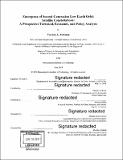Emergence of second-generation low earth orbit satellite constellations : a prospective technical, economic, and policy analysis
Author(s)
Foreman, Veronica L. (Veronica Lynn)
DownloadFull printable version (22.87Mb)
Other Contributors
Technology and Policy Program.
Advisor
Olivier de Weck and Afreen Siddiqi.
Terms of use
Metadata
Show full item recordAbstract
Modern proposals for Low Earth Orbit (LEO) satellite constellations underscore the tremendous potential and versatility of distributed spacecraft missions (DSMs), but they have also begun to stress the limits of the existing development paradigm. A new generation of LEO constellations is emerging, and understanding the related technical, economic, and policy landscapes will be critical to fostering their success. The most significant value of this research effort comes from its breadth. LEO constellations are becoming essential tools for a wide range of applications, and this work seeks to examine the diverse set of topics facing modern constellation stakeholders. Through a multidisciplinary, systems engineering evaluation, this thesis synthesizes current knowledge gaps and questions related to second-generation LEO constellations. The investigation begins with a discussion of the historical development of DSMs, and three distinct eras of constellation use are identified. The initial time period, 1959 to 1996, captures the early DSMs that framed the development of modern systems. The first generation spans from 1997 to 2009. It begins with the installation of the first commercial, telecommunications constellations and demonstrates logistic growth for commercial DSM member spacecraft. Growth rates surge again as the second generation begins in 2010, and the data reflect current trends toward commercial, remote-sensing applications of DSM systems. The second generation of LEO constellations coincides with an approximately 189% increase in the annual NGSO satellite launch rate and a 92% increase in the number of constellation systems initialized each year over the first generation. This work continues by underscoring technologies that have enabled this growth through a survey of relevant literature and patent filings. Contemporary issues in constellation technology policy are also examined. Through a series of cost and risk focused case studies, limitations within the existing development and maintenance paradigms are illustrated. The new generation of constellations is challenging the assumptions that have traditionally guided such analyses, and opportunities for further framework development are discussed. This thesis represents a contribution to the advancement of constellation systems by assessing the viability of the existing paradigm and identifying critical areas of future research.
Description
Thesis: S.M., Massachusetts Institute of Technology, Department of Aeronautics and Astronautics, 2018. Thesis: S.M. in Technology and Policy, Massachusetts Institute of Technology, School of Engineering, Institute for Data, Systems, and Society, Technology and Policy Program, 2018. Cataloged from PDF version of thesis. Includes bibliographical references (pages 133-145).
Date issued
2018Department
Massachusetts Institute of Technology. Department of Aeronautics and Astronautics; Massachusetts Institute of Technology. Engineering Systems Division; Massachusetts Institute of Technology. Institute for Data, Systems, and Society; Technology and Policy ProgramPublisher
Massachusetts Institute of Technology
Keywords
Aeronautics and Astronautics., Institute for Data, Systems, and Society., Engineering Systems Division., Technology and Policy Program.